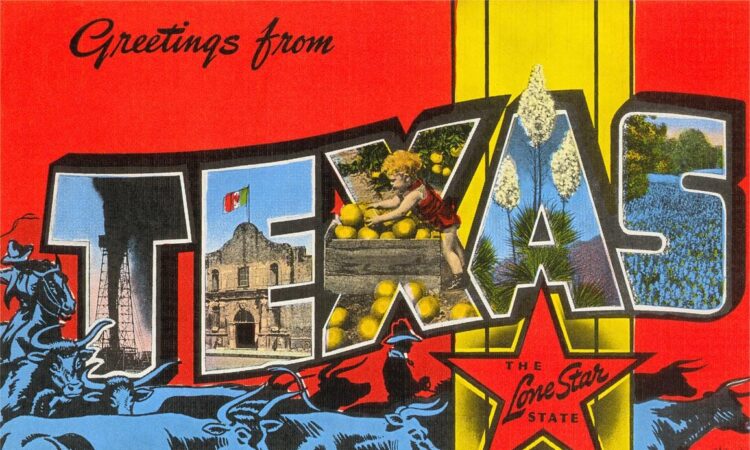
I tried to cross-tally the list of funds and companies banned by the Texas Comptroller with the publicly available holdings of Texan state pension funds. I found little overlap. Of course, not all disclosures are publicly verifiable or available, but I have to wonder whether the banned list was even meant to bite.
Vintage illustration of Greetings from Texas, the Lone Star State large letter vintage postcard, … [+]
ESG and politics have become inextricably intertwined in the last six months or so. A prominent initiative along these lines is the announcement of Glenn Hegar (the Texas Comptroller) that Texas state agencies have to divest from 348 specific funds and 10 asset management companies that promote ESG. In particular, on August 24, 2022, Glenn Hegar directed the Employees Retirement System of Texas, Teacher Retirement System of Texas, Texas Municipal Retirement System, Texas County and District Retirement System, Texas Emergency Services Retirement System, and the Permanent School Fund to notify his office within 30 days if the pension funds held the banned ESG funds or investments administered by the banned asset management companies. The 10 banned asset management companies are BlackRock, BNP Paribas SA, Credit Suisse Group AG, Danske Bank A/S, Jupiter Fund Management, Nordea Bank, Schroders PLC, Svenska Handelsbanken, Swedbank AB and the UBS Group AG.
Note that BlackRock is the only U.S. asset manager on the list (assets under management or AUM of $8 trillion). The list is curiously heavy on Scandinavian banks who have relatively small AUMs (Danske’s $100 billion Nordea’s $248 billion Euros, Swedbank’s 166 billion Euros, and Svenska’s 65 billion Euros). Because the other nine asset management companies, other than BlackRock, are all European or U.K. based, one has to ask what the ban really amounts as the direct equity holdings of Texan pension funds in European companies is likely small. Should we even expect the Texan pension funds to have investments in any of the banned companies except perhaps for BlackRock and UBS?
Hence, my initial reaction to the announcement was to wonder how relevant the divestment order was for Texan public pension funds anyway. On top of that, most state pension funds invest a large portion of their assets in market wide indexed funds such as the S&P 500 that are not all that affected by the ESG label. The rest of the money is in private equity or alternate investments, which are traditionally opaque about ESG and projects they invest in. Hence, my hypothesis was that the potential overlap between the banned list that Glenn Hegar published and investments held by Texan state pension funds was likely to be small.
I set to find out whether the data are consistent with my hunch. To do so, I pulled up the last known list of investments published by these Texas pension funds and compared that with the list of 348 funds that are “blacklisted.”
Teacher Retirement System of Texas (TRS)
Teacher Retirement System of Texas (TRS) held around $160 billion. The composition of their asset base is as follows: (i) 21% of stable value investments (treasuries 16%, stable value hedge funds 5%); (ii) 54% in global equity (18% in U.S., 13% in non-USA developed, 9% in emerging markets and 14% private equity); and (iii) 21% in what they call real return strategies (real estate 15%, energy 6%). Again, I could not find a list of funds held but I did find stocks held by TRS on S&P CAP IQ. TRS held $13.9 billion in 2011 public equities.
The top 10 stocks held by TRS are the usual suspects except for a couple of ETFs sold by Vanguard: (i) Apple ($796 million); (ii) Vanguard FTSE Emerging Markets ETF ($712 million); (ii) Microsoft ($551 million); (iii) Amazon ($339 million); (iv) Alphabet ($315 million); (v) Vanguard S&P 500 ETF ($258 million); (vi) Shell ($241 million); (vii) iShares S&P 500 ETF ($231 million); (viii) Tesla ($183 million); (ix) United Health ($172 million); and (x) Johnson and Johnson ($168 million). Interestingly, CAP IQ reports an iShares holding, a BlackRock brand. That will probably be sold and replaced by Vanguard’s S&P 500 ETF, I presume.
The list of top investments held by TRS appears to resemble the bigger holdings in the S&P 500 index. It is also interesting to note that included in their top 10 holdings is a European oil company, Shell, but not an American oil company such as Exxon. Exxon has a far bigger market cap ($417 billion) than Shell ($173 billion) and Exxon is headquartered in Texas. One also has to wonder why oil and gas companies do not figure more prominently in the top 10 investments held by TRS and the other Texan pension funds I looked at for this piece.
I also checked the positions that TRS exited in the recent past after 8/24/22 announcement. The exits were Healthcare Trust of America, Inc., Whiting Petroleum Corporation, Mobile TeleSystems, Hanger, Inc., Vonage Holdings Corp., Mandiant, Inc., Healthcare Realty Trust Incorporated, Epizyme, Inc., CDK Global, Inc., Metromile, Inc., Meritor, Inc., Biohaven Pharmaceutical Holding Company Ltd., Global Blood Therapeutics, Inc., GCP Applied Technologies Inc., Turning Point Therapeutics, Inc., Plantronics, Inc., ManTech International Corporation, Coherent, Inc., Sanderson Farms, Inc. and PS Business Parks, Inc.
Healthcare Trust, Whiting, Metromile, Turning and Epizime were involuntary exits on account of mergers and the like. I may be wrong, but the other exits do not look particularly pro or anti ESG to me.
Texas Emergency Services Retirement System (TESRS)
Texas Emergency Services Retirement System (TESRS) had $141 million as of 8/31/21. TESRS ‘ asset allocation on that date: (i) short term investments (0.8%); (ii) U.S. large cap equities (24%); (iii) U.S. small and midcap equities (10.2%); (iv) international equity in developed markets (15%); (v) international equity in emerging markets (5%); (vi) core fixed income (21.7%); (vii) non-core fixed income (8.9%); (viii) U.S. core real estate (7.3%); and (ix) multi-asset investments (7%).
The TESRS report as of 8/31/21 lists the funds that the pension system invests in. I did see a holding in BlackRock Multi-Asset Inc-K #1981 of $10.11 million. I saw lots of investments in the usual suspects such as Amazon and so on but nothing in the banned banks or in ESG funds.
Texas Permanent School Fund
Texas Permanent School Fund, as per its disclosure as of 8/31/21, has $52 billion in assets. I saw an investment in BlackRock, the company, but not in ESG funds.
Texas County and District Retirement System (TCDRS)
Texas County and District Retirement System (TCDRS) has assets of $45 billion as of 12/31/21. TCDRS’ asset allocation looks like this: (i) 29% in credit; (ii) 25% in equities; (iii) 25% in private equity; (iv) 10% in real assets; (v) 6% in hedge funds; and (vi) 5% in investment grade bonds and cash. S&P CAP IQ does not have detailed data on their public equity holdings.
Employee Retirement Systems of Texas (ERS)
Employee Retirement Systems of Texas (ERS) held around $33 billion in assets as of August 2022. The composition of the assets: (i) 33% of public equity; (ii) 20% in private equity; (iii) 9% in global credit; (iv) 3% in public real estate; (v) 5% in infrastructure; (vi) 11% in rates strategy; (vii) 5% in hedge funds; (viii) 1% each in special situations and in cash. It is hard to think of ERS holding the objectionable ESG funds in any category other than in public equity. I looked but not find a list of funds (not companies) held by ERS.
The top 10 stocks held by ERS are the usual suspects in the S&P 500 index: (i) Apple ($340 million); (ii) Microsoft ($252 million); (iii) Amazon ($148 million); (iv) Alphabet ($139 million); (v) United Health ($88 million); (vi) Tesla ($81 million); (vii) Johnson and Johnson ($77 million); (viii) ExxonMobil ($68 million); (ix) Prologis ($62 million); and (x) Berkshire Hathaway ($59 million).
Before you argue that this must represent holdings post the Glenn Hegar announcement, I checked the positions that ERS exited after the Hegar announcement. The exits were Healthcare Trust of America, Inc, Cedar Realty Trust, Inc., Healthcare Realty Trust Incorporated, Duke Realty Corporation, Noble Corporation Plc, and Hemisphere Media Group, Inc.
Of the six exits, three were involuntary as Healthcare Trust, Healthcare Realty Trust, and Noble Corporation got acquired. The remaining exits do not look pro or anti-ESG to me.
Texas Municipal Retirement Systems (TMRS)
Texas Municipal Retirement Systems (TMRS) has assets of $38 billion as of 12/31/21. The asset allocation looks like this: (i) global public equity (32.8%), (ii) private equity (9.8%); (iii) core fixed income (5.0%); (iv) non-core fixed income (20.6%); (v) real estate (12.5%); (vi) other public & private markets (11.0%); (v) hedge funds (7.8%); and (vi) cash equivalents (0.5%).
S&P CAP IQ does not list public holdings of TMRS. TMRS’s public disclosure as of 3/31/22 suggests that they hold $6.8 billion in MSCI USA IMI Fund and $3.9 billion in NTGI ACWI ex. US IMI (NL). Nothing pro and anti-ESG here.
So, where does this leave us? I am not able to find much overlap between the list that Glenn Hegar published with what is actually held by the Texan pension funds. I realize that the securities held by the pension funds are probably administered by BlackRock or by one of the banned asset management firms and that affiliation is perhaps not publicly disclosed. Moreover, I only have access to public data, and I might have inadvertently missed a few disclosures. You could always argue that it is highly disturbing to be shut off from future business opportunities.
Yet, after this exercise, I have to wonder whether the banned list had or was meant to have real bite. Given that it’s unlikely these Texas pension funds would hold stock in this list of relatively small European financial institutions (BlackRock is the only exception) in the first place, could the Hegar announcement simply represent political grandstanding?






